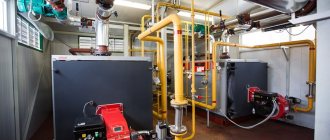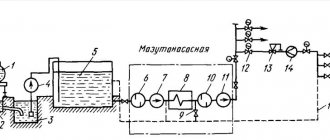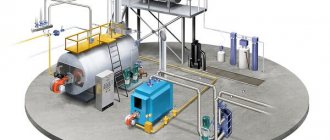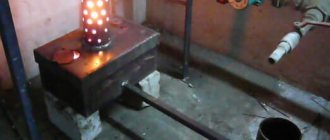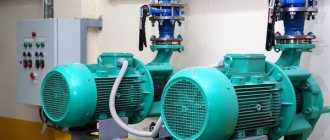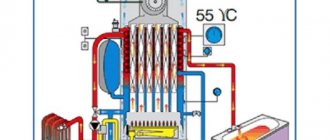Backup boiler paired with an electric boiler
Electrical networks in the current state they are in cannot be considered a guaranteed source of energy for heating a home. This means that any heating system using electricity must be duplicated.
If you have an electric heating boiler with a liquid system installed, you need to select a backup for it - a backup boiler that will work during periods of power outages or at times when not all phases have sufficient voltage to heat the house.
Which backup boiler should I choose to pair with an electric one? This can be any boiler with an autonomous fuel supply:
- Diesel boiler with a tank for diesel fuel.
- Solid fuel boiler with a supply of firewood, coal or pellets.
- Gas boiler on a gas train or connected to a gas holder.
If you heat your house with a system of electric convectors, it is not economically feasible to install a backup liquid heating system with radiators and a boiler. In this case, it is better to use an air heating furnace as a backup heat generator. This could be a stationary brick stove, a steel or cast iron stove, or a fireplace stove.
These can also be gas convectors, powered from a system of gas cylinders with a decent volume - 27 or 50 liters.
Since electricity is the most expensive energy carrier for heating, any heat generator using any fuel can perform the function of backup heating.
LPG as a backup fuel for boiler houses
In many developed countries (USA, Canada, etc.), the use of LPG as a backup power source for boiler houses running on natural gas is a standard solution. Despite the obvious advantages over traditional alternative backup power sources (diesel fuel, heating oil, coal), it is nevertheless not widespread enough in Russia.
LPG is cheaper than fuel oil and diesel fuel, and is much more environmentally friendly. The LPG storage park does not need to be heated in winter, which reduces operating costs. It is much more difficult to steal, which is also important in Russian conditions. When using a mixing system, the transition from natural gas to a mixture of air with the vapor phase of LPG is carried out almost instantly and unnoticed by the consumer.
Why is such a solution unclaimed in Russia? One of the reasons is the lack of practice in using mixing systems in Soviet times. In theory, they are known quite well; a description of the principles of their operation is in many Soviet and Russian textbooks on gas and heat supply. But since we almost never produced such equipment, the experience of using it is extremely limited.
Rice. 1 Diagram of a boiler room with backup diesel fuel
In recent years, more than 20 large facilities using LPG as a backup fuel have been designed, built and put into operation by specialists. In approximately half of the cases, these technical solutions include mixing systems. Among them are a backup source of gas supply for the Olympic torch at the Olympic Games in Sochi - 2014 (LPG storage tank farm V = 400 m3, mixing system with a capacity of 2830 m3/h for natural gas), reconstruction of the heat supply system of the Nesvetay-GRES village and four microdistricts of the city of Krasny Sulin, Rostov region (boiler house with a capacity of 19.3 MW, LPG storage tank farm V = 225 m3, mixing system with a capacity of 708 m3/h for propane), etc. The economics of the costs of construction and operation of backup power systems allows us to talk about good prospects for its use in Russia. And here we cannot ignore the current regulatory framework.
Reserve fuel for boiler houses is intended for use when the supply of natural network gas is limited or stopped for a long period of time (within the framework of the “Gas Supply Rules in the Russian Federation”), which is associated with seasonal unevenness in gas consumption during peak loads.
According to clause 4.1 of SNiP II-35-76 “Boiler installations”, the types of main, reserve and emergency fuel, as well as the need for reserve or emergency fuel for boiler houses are established taking into account the category of the boiler house, based on local operating conditions and in agreement with fuel supply organizations.
In practice, fuel reservation is used in boiler houses of socially significant facilities with special requirements of sanitary rules and regulations for central heating and hot water supply systems (primarily hospitals, schools, preschool institutions, etc.).
The most common backup fuels are liquid hydrocarbons (diesel fuel, fuel oil), liquefied hydrocarbon gases (LPG), and, less commonly, solid fuels (coal, peat, firewood). Below we propose to consider the concept of using liquefied hydrocarbon gases (usually a propane-butane mixture in various proportions) in comparison with the most commonly used diesel fuel.
Rice. 2 Diagram of a boiler room with LPG fuel reserve
In boiler rooms with a relatively small supply of diesel fuel, the tank is mounted in an additional auxiliary compartment, hermetically separated from the main one. In boiler houses of greater power and/or with a large emergency reserve (Fig. 1.), fuel storage is arranged in special above-ground or underground tanks. In this case, fuel is supplied to the burners using pumps. When the tanks are located on the ground, it is also possible to have heating elements for heating diesel fuel during the cold period.
In boiler systems using LPG (Fig. 2), fuel storage tanks are located below ground level. The main elements of the equipment of such a boiler house are also the technological piping of the tanks, a pumping group, evaporation and mixing systems, often combined into one unit. The steam phase is supplied to the boiler room burners through thermally insulated pipelines.
The most effective way to use LPG as a reserve fuel is to mix it with air to achieve the calorific value of natural gas. In English-language literature, such a mixture of LPG and air is called SNG (synthetic natural gas). At the same time, at the moment the automation switches from natural gas to SNG, the boiler room equipment “does not notice” such a change, since both types of fuel are almost identical.
Let's consider diesel fuel and LPG from the point of view of the volume and cost of daily consumption at maximum boiler load per 1 MW, conditionally assuming equal boiler efficiency, the cost of equipment, installation and operation of boiler houses of the same capacity with a reserve in the form of diesel fuel and LPG. As LPG we will consider a propane-butane mixture of the PBT brand with a propane content of no more than 60% according to GOST 52087.
Daily fuel consumption is calculated using the following formula:
V t.s.=(Рн x 24)/(efficiency factor x Qв)
V t.s. – daily volume of fuel consumption (l; m3) Рн – rated power of the boiler house (kW) KPDk – efficiency factor of boilers Qв – specific heat of combustion of fuel per calculation unit (l; m3)
With efficiency factor = 0.95, specific heat of combustion of diesel fuel 11.9 kW/l, specific heat of combustion of the LPG mixture equal to 12.5 kW/kg, mass/volume ratio 1.76 (density coefficient of PBT brand LPG = 0.568, temperature = 0ºС) we obtain the results given in Table 1.
The table shows that, with all other parameters being equal, heating a boiler room with liquefied hydrocarbon gases is almost 1.7 times cheaper than with diesel fuel. And, of course, the positive effect of using LPG increases over the period in direct proportion to the volume of use of reserve fuel. At the same time, we do not consider the cost of heating containers with diesel fuel in the winter, which can also be a serious cost item. According to the practice that has developed in the regions, heating of containers in the cold season is often not carried out at all, which makes it virtually impossible to start a backup power system.
In addition, compared to diesel fuel, LPG has a number of other advantages:
- The liquid phase of LPG, having the same basic physical properties of a liquid as diesel fuel, is nevertheless not subject to a significant increase in viscosity at low temperatures (which negatively affects the transportation of diesel fuel from external storage to the burners), since its vapor phase is supplied to the boiler room
- provides the ability to automatically switch from the main fuel to the reserve one
- there is no need to use more expensive combined burners in boilers to be able to burn both gaseous and liquid fuels
- the cost of building the module is reduced due to the absence of an auxiliary room (which is necessary in the case of placing diesel fuel storage tanks inside the boiler room)
| V t.s., l | Average market wholesale cost, rub./l | Cost of fuel consumption, rub./day. | |
| Diesel fuel | 2 123 | 31,61 | 67 106,50 |
| LPG | 3 557 | 11,10 | 39 483,00 |
Table 1 – Cost of daily fuel consumption of a boiler house per 1 MW of power
We should also not forget about the environment. Combustion of diesel fuel entails disproportionately greater emissions of soot, sulfur oxides and nitrogen oxides than combustion of SNG.
It is also necessary to take into account, unfortunately, the typical situation for Russia with the theft of diesel fuel. Diesel fuel is written off and sold, and the proceeds are appropriated. It is much more difficult to steal and sell LPG on the black market.
No less important is the aspect related to the possibility of more rational management of network natural gas consumption limits. LPG allows for more flexible use of the so-called “gas consumption armor” during the heating period, that is, the minimum volume of gas consumption required for trouble-free operation of process equipment, subject to maximum use of reserve fuels.
We see the most promising use of LPG as a reserve in the following cases:
- when modernizing existing boiler houses of public utility facilities to create a reserve or emergency fuel supply
- during the construction of new facilities in conditions of limited limits on natural gas, as well as with a guaranteed prospect of growth in heat and hot water consumption in the future
The steady increase in prices for liquid hydrocarbons in the domestic market, their dependence on the situation on world trading floors, as well as the two-fold increase in the domestic consumption market projected by 2021 compared to today, make the concept of using LPG as a reserve fuel the most promising.
Rice. 3 SNG Metan production plant in a warehouse
Features of boiler houses using LPG
In accordance with PB 12-609-03, when modernizing existing boiler houses and constructing new ones, the following points should be taken into account.
- Shut-off valves, as a rule, should be made of steel, taking into account climatic conditions and operating gas pressure (clause 2.4.4.).
- The design of safety shut-off valves must comply with the requirements of state standards GOST 9544-2005, ensure strength, resistance to SUG and be at least class “A” in terms of tightness.
- The design of the shut-off valves must comply with the requirements of state standards GOST 9544-2005, ensure strength, resistance to LPG and be at least class “B” in terms of tightness (clause 2.4.5.).
- The ventilation system must provide 10-fold air exchange during working hours, with 2/3 of the air intake from the lower zone of the room and 1/3 from the upper zone. If there is insufficient air exchange, working with liquefied hydrocarbon gases is not allowed. Electric motors of exhaust fans must be explosion-proof (clauses 5.5.16-5.5.28)
Authors: S.V. Zubkov, Marketing Director of Gazovik Group of Companies, E.A. Karyakin, Development Director, Gazovik Group of Companies
Bibliography:
- GOST 52087-2003. Hydrocarbon liquefied fuel gases. Technical conditions. Enter 2003-06-30. – M.: Gosstandart of Russia, 2003
- GOST 9544-2005. Pipeline shut-off valves. Classes and standards of tightness of valves. Enter 2008-04-01.– M.: Standartinform, 2008
- Safety rules for facilities using liquefied hydrocarbon gases: PB 12-609-03: approved. Gosgortekhnadzor 05.27.03. – M., 2003
- Boiler installations: SNiP II-35-76: approved. GC SM for construction affairs 12/31/76: entry into force from 01/01/78 - M., 1977
- Rules for Gas supply in the Russian Federation: approved. Government of the Russian Federation 5.02.98: as amended. from 07.12.05 and 10.05.10 – M, 2010
- Industrial gas equipment: reference book. 6th ed., revised. and additional / ed. Karyakina E.A. – Saratov: Gazovik, 2013
- Karyakin E.A., Gordeeva R.P. Equipment for LPG//Gas of Russia. – 2013, No. 1. – pp. 58-64
- Zubkov S.V., Karyakin E.A., Polyakov A.S. Gas supply without interruptions // Gas of Russia. – 2014, No. 1. – pp. 68-75
- February 10, 2021
Production of a batch of gas control units "Gazovichok"
- January 21, 2021
Fill out the questionnaire for the boiler room online
- December 30, 2020
Work schedule of Gazovik Group of Companies during the New Year holidays
- December 28, 2020
New Year's greetings from Gazovik Group of Companies
- December 02, 2020
New production: Electromagnetic gas valves with manual cocking!
- November 03, 2020
Manufacturing and shipment of a batch of GRU
- October 02, 2020
New production: Pointer type differential pressure indicator!
- 04 September 2020
The production of valves and filters DN-200 in an aluminum casing has been mastered
- September 03, 2020
Russian gas will be sent to southern China
- 06 July 2020
We have expanded the range of valves with electric drive for flow regulators.
All news…
Backup boiler paired with a gas boiler
In the case when gas consumption in the gas pipeline increases during frosts, the final household at the end of the “pipe” may be left with virtually no gas. Some models of gas boilers will not be able to start and operate at minimum pressure in the gas main. Accidents on the gas main can also occur for various reasons - from illiterate excavation work to cases of arbitrary tapping into the gas main.
In this case, as well as in the event of gas equipment failure, for a period sufficient for the emergency team to leave, you will need a backup boiler in tandem with the gas boiler.
What are the possible options here? Any solid fuel or diesel boiler will be able to support your heating system while an accident on the main line is being repaired or gas equipment is being repaired.
If you have the opportunity to be at home during an accident, you can choose wood or coal boilers. If you need to leave at this moment, choose fully automatic diesel or pellet boilers.
The model in this case does not matter; what matters is the reliability of the backup boiler. For this reason, you should not reserve gas heating with electric boilers or convectors. Because electricity is an even less reliable form of energy for heating than mains gas.
Backup duration
When choosing a backup power source, it is necessary to determine the duration of the backup in each specific case. First, we need to understand what types of power outages we are dealing with.
In simple terms, power outages can be divided into the following types:
- short-term power outages lasting several minutes (such outages are associated with deterioration of electrical networks);
- power outages lasting up to one hour (such outages occur during technological work on lines);
- power outages lasting up to 24 hours (such outages occur during rolling blackouts, when there is a lack of energy in the area);
- power outages lasting up to several days (such outages occur during accidents on power lines or transformer equipment).
For each of these cases, a different solution to the problem of backup power supply to the heating system is required. For outages lasting up to one hour, you can use a backup power source with medium-capacity batteries. For outages lasting up to 24 hours, you can use a backup power source with high-capacity batteries. For outages lasting more than 24 hours, you can use a backup power source with high-capacity batteries and a gasoline electric generator.
As a note, we note that if it is not possible to install a gasoline electric generator, then you can use backup power sources with batteries of the largest capacity and increase the battery life of the equipment by using a periodic schedule for the operation of heating system devices.
Backup boiler paired with a diesel boiler
The best option for backing up liquid fuel heating would be either a second diesel boiler or a solid fuel boiler, as well as a gas boiler powered by a gas train - several cylinders connected to supply gas to the heat generator.
A second diesel boiler will work if your main unit fails. The backup will be powered from the same tank as the main heat generator.
If there are problems with the supply of diesel fuel or with the timely purchase and delivery of fuel, then a backup boiler using a different type of fuel will help out.
Connecting a backup electric boiler to a solid fuel boiler - let’s look at the nuances of the circuit
Most often, backup is performed by an electric boiler, which:
- has the highest reliability among all boilers, according to statistics more than 99%;
- is inexpensive;
- can serve not only as a reserve, but also as an active assistant for a solid fuel boiler, turning on when no firewood is added, or for heating at night, and can have the ability to program its operation.
- is the most comfortable heat generator in terms of maintenance.
It has one drawback - the highest price of electrical energy.
Why is an electric boiler usually installed?
Most often, simple housing circumstances require installing an electric boiler in addition to a solid fuel one. By the middle of the night, the firewood is completely burned out and the house becomes cooler. Residents need to wake up and service the boiler again, or it will be noticeably colder by morning.
- The use of an automatically switched-on electric boiler allows you to avoid such intense conditions. It is also possible to use electricity to maintain a minimum positive temperature, etc...
Can a combi boiler replace two boilers?
Almost all manufacturers of solid fuel boilers make so-called combinations - they combine several heating methods in one unit. As a rule, solid fuel boilers are complemented by a small built-in electric boiler, or rather even a heating element, designed to operate from a 220 V network and a power of 3 - 5 kW, which is enough to maintain above-zero temperatures, or even heat a small house in not too cold times.
These built-in heaters are activated by temperature sensors based on the temperature of the coolant at the outlet of the boiler and (or) room air. Therefore, electric heating can turn on either when the boiler burns out and the coolant begins to cool, or when the temperature in the house drops below the minimum.
- In fact, electric heating in a solid fuel boiler is an important useful option, allowing, for example, to maintain a minimum temperature in a country house, or to heat it up at night...
But it does not reserve either the boiler pump or its hydraulic part. If they fail, the house will be left without heating. In addition, most of these boilers do not have time programming, as well as sufficient power and power regulation for three-phase networks to fully heat the house. All this is achievable if you use a more expensive but comfortable solution - a combination of a solid fuel boiler and an automated electric one.
Connecting an electric boiler as an auxiliary one
If the electric boiler must operate frequently, then the piping is done with automatic switching of the coolant flow through the boilers without human intervention. Check valves are used here, which are installed according to the following scheme. They turn towards each other.
- When the electric boiler is turned on, its pressure closes the check valve in the solid fuel branch, so the movement of liquid there stops.
- When the electric boiler is turned off, the main pump closes the check valve in the electric boiler branch, and the movement of liquid through it also does not occur.
It is also important to link the operation of boiler pumps depending on the temperature of the coolant and the air in the room. The classic scheme for piping two boilers implies the following.
- The solid fuel boiler pump is turned on and off by the supply coolant temperature sensor. As soon as the flame has stopped and the coolant has cooled, the main pump is turned off so as not to drive the coolant through the cooled heat exchanger.
- The electric boiler starts up at the command of the room thermostat (by air temperature), or by time. When it gets cool, the electric boiler and its pump come into operation.
The issue of simultaneous operation of two pumps, and the issue of uninterrupted circulation of liquid through the solid fuel pump, is solved by selecting the operating pressure of the pumps.
What is taken into account when reserving an electric boiler?
- Liquid movement through a solid fuel boiler is not allowed when it has stopped burning. In this case, the coolant passing through the heat exchanger will be cooled by natural draft to the chimney, and energy losses will be very impressive. It can be solved by turning off the pump after the wood has finished burning using a temperature sensor (a common option for boilers...) and by having a check valve opposite the electric boiler...
- It is imperative to ensure that the liquid moves through the solid fuel boiler constantly, without interruptions even for a few minutes, as long as there is combustion in it. Otherwise, the system may boil and explode. To prevent this, an uninterruptible power supply (UPS) is included in the pump power circuit. The pump itself is installed only on the return line, where steam cannot enter it.
- The pump of a solid fuel boiler must have a higher operating pressure than in an electric boiler, so that in any case it is possible to create fluid movement through the solid fuel heat exchanger until the thermal relay turns off this pump ("no combustion" mode). When choosing equipment, this condition must be taken into account.
- If the electric boiler is selected only as an emergency one, designed to be turned on when the solid fuel boiler breaks down, which may not happen at all, then check valves are excluded from the hydraulic circuit. The electric boiler can be turned on only in manual mode, with manual opening/closing of the shut-off valves installed on the nozzles.
Backup boiler using the same type of fuel
In comments on the website and in letters to the editor's email, our readers asked questions several times: is it worth running a system consisting of two heat generators using the same type of fuel?
You can install two solid fuel or diesel boilers in combination. In this case, the fuel source is autonomous, and if it is available, the backup boiler will operate successfully.
In the case of main gas and electricity, installing a backup boiler only saves you if the heat generator itself fails. In the event of an accident on a power line or gas main, you will still need a boiler using alternative fuel.
More on this topic on our website:
- We choose a backup power supply for the boiler - generator, UPS, inverter. Winter, frost, smoke from the chimney. The picture is like a postcard. A good owner prepared in advance, the boiler was installed in the fall, it works perfectly, heats...
- Two boilers in a boiler room - how to connect - pros and cons Let's start with the fact that in a modern house located in the middle zone there should be 2 boilers. It doesn’t even have to be 2...
- Universal heating boilers for a private home Why are universal heating boilers needed for a private home, what justifies their use, why is it worth buying them? In what situation...
- UPS for TT boilers - differences and features We have already talked about gas boilers, about what UPS for a heating boiler using main gas is needed and should be...
Why do you need a protection system?
Let's look at possible options for creating backup heating systems. The most reliable and progressive option is a modular protection system that can warn the user about a malfunction of the main heating equipment.
In the event of an emergency with the main boiler, sensors instantly signal a drop in temperature, and the backup boiler starts automatically. Thus, leaving your home for a long time in winter, you will be sure that you are insured against an accident and subsequent troubles associated with overcooling of the heating system.
Reserve boiler
Automation will immediately inform you about malfunctions. If the gas pressure drops below a preset level, the main boiler will not go into error due to the presence of a flame; after eliminating the cause of the failure, a restart will not be necessary and the presence of a service technician will not be required.
